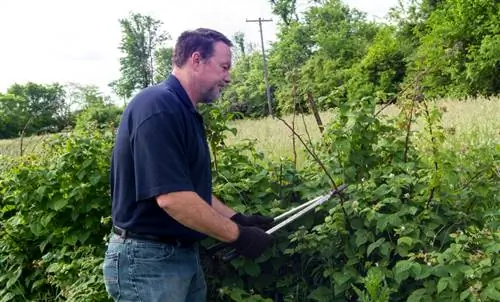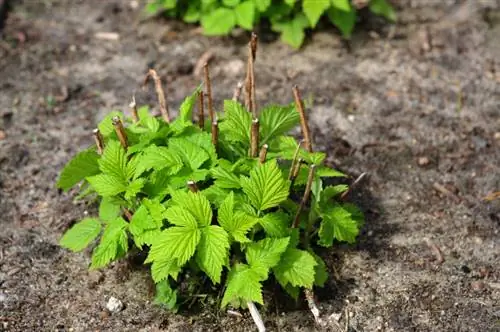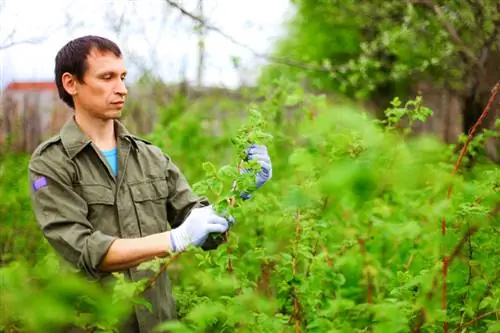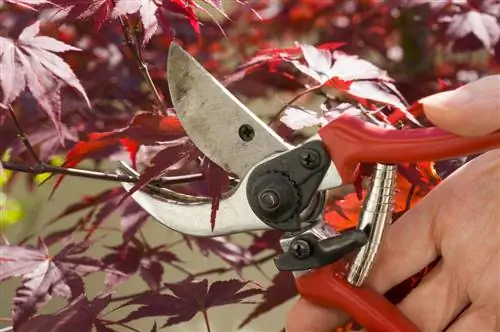- Author admin [email protected].
- Public 2023-12-16 16:46.
- Last modified 2025-01-23 11:19.
Pruning raspberries is one of the most important care measures. If you do not remove the harvested shoots, you will wait in vain for the raspberry harvest next year. But you also have to remove sick and weak rods.
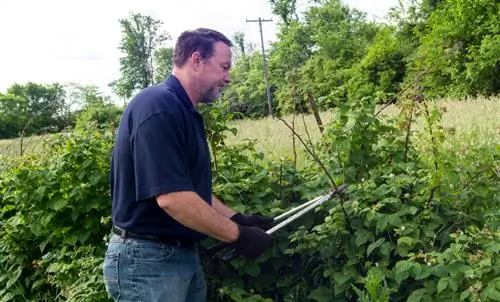
How do you prune raspberries correctly?
Raspberries should be pruned differently depending on the variety: With summer raspberries, every two-year-old cane after the harvest, sick and weak shoots are continuously removed. For autumn raspberries, all canes are cut back completely in autumn and diseased shoots are removed during the growing season.
Cutting back raspberries
Summer raspberries and autumn raspberries are pruned differently.
Summer raspberries only bear their fruit on two-year-old canes, while autumn raspberries grow on one-year-old canes.
So before you prune your raspberries, you need to know what variety your perennials are. One clue is the harvest time. Summer raspberries are harvested in July. The harvest of autumn raspberries does not begin until August.
Tips for cutting raspberries coming soon
Cutting back summer raspberries
- Cut all two-year-old canes after harvest
- Constantly remove sick and weak shoots
- Thinning out rods that are too close together
- Shortening rods that are too long
Pruning autumn raspberries
- Cut all canes back completely in autumn
- Remove diseased shoots during the growing season
- Thinning out perennials regularly
- If necessary, cut down shoots that are too long
The harvested canes are cut down to the ground. Don't leave any leftovers. They are a good breeding ground for diseases.
Cutting back the raspberries as a care measure
Raspberries are very susceptible to fungal diseases. To limit the spread of fungal spores, the plants should not be too close together. A maximum of 15 canes are sufficient per perennial. Cut out all excess shoots.
Through thinning you ensure that air can circulate between the rods. This allows the above-ground parts of the plant to dry well.
This deprives the spores of their foundation because they need moisture to spread.
Remove sick and weak rods
Root rot and cane disease are among the most common diseases of raspberries. They become noticeable when the leaves of the affected canes turn yellow and dry out. Eventually the entire shoot dies.
Therefore, cut off all diseased canes as soon as possible and do not try to treat them first. Do not dispose of the infected canes in the compost, but rather burn them or throw them in the household waste.
You should also remove weak rods. They only bear a few fruits and rob the plant of unnecessary strength.
When to prune your raspberries
Cut the harvested canes of summer raspberries straight after harvesting in summer. For autumn raspberries, wait until autumn because the perennials will continue to produce until the onset of frost.
You can cut back sick canes or shorten shoots that are too long throughout the gardening year.
Tips & Tricks
Gardening experts recommend growing summer raspberries on a V-frame. The one-year-old rods are only tied to one side of the trellis, the two-year-old rods to the other side. This makes pruning easier because you know exactly which shoots are annual and which are biennial.

